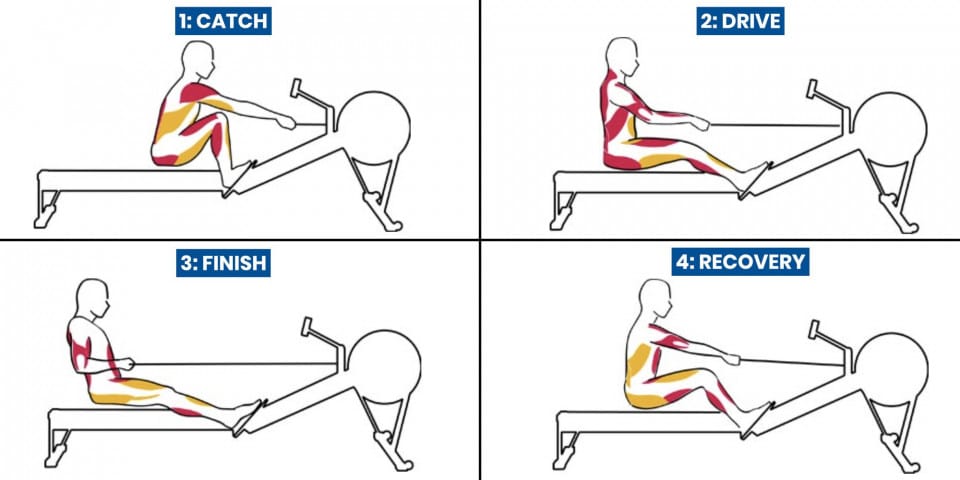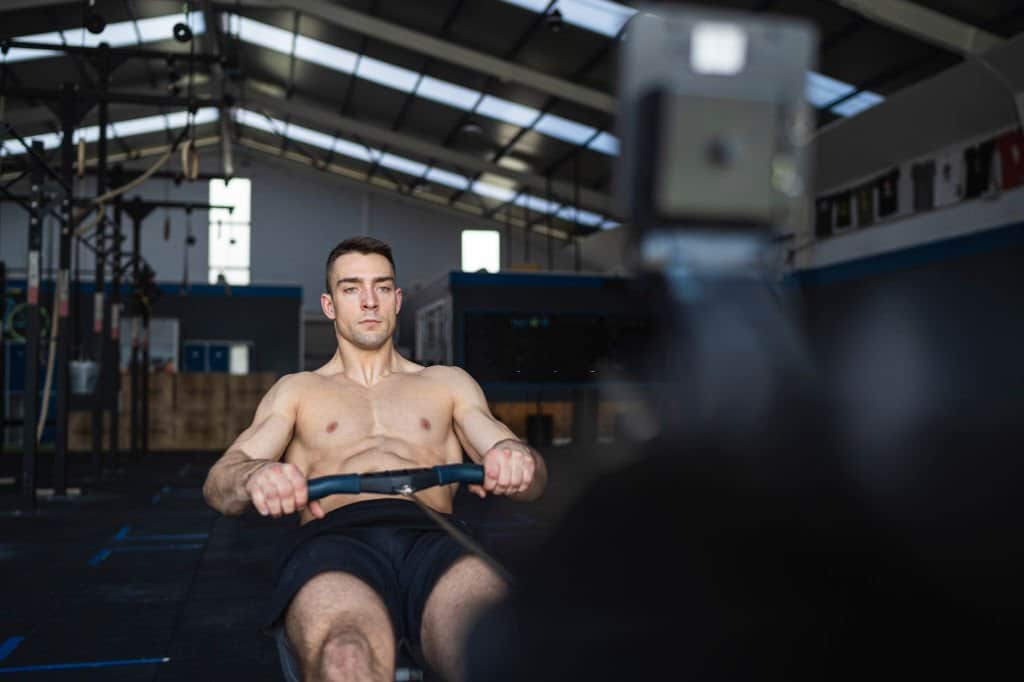Rowing is a great way to exercise and tone your muscles. It’s also a cardiovascular exercise that will have you breaking a sweat in no time. A common misconception is that rowers only work their upper body.
In reality, it is one of the best all-around exercises because it works numerous muscles simultaneously and helps burn fat. It is one of the most effective and efficient ways to build back, shoulder, legs, hip, and core muscles. Being a highly intensive workout, rowing builds stamina. So, what muscle groups do rowers work in? Here’s a comprehensive guide to rowing workouts.
Jump to:
The Muscles Involved in Rowing Work

The rowing machine is a piece of equipment that simulates the rowing motion on water. When you use it, you sit on a seat with handles attached to a chain or cables. You pull back on the handle while pushing off with your legs, just like when you row in real life.
As we have seen, rowing is a comprehensive workout that engages various muscle groups. Additionally, rowing is a non-weight-bearing exercise, making it easy on the joints. This is definitely the workout for you if you’re searching for a low-impact workout.
The main muscles that rowers work are the following.
Based on our testing, this is the best rower for beginners. For less than 500$, this silent water rower will last you for years. It also comes with a 12-year warranty.
- Affordable
- Quiet
- Amazing warranty
Quadriceps And Hamstrings
The quadriceps and hamstring muscles are two of the most critical muscles for rowing. Quads are large muscles located in the front of your thighs. They help you in forward limb movement. In addition to rowing, you engage the quads in actions such as walking, running, jumping, and kicking.
The hamstrings are on your backside. They run from your hips to where they connect with your knees. They help extend (straighten) your knee joint and aid in bending at the hip during a push-off.
Strong quads and hamstrings are essential for all rowers, regardless of body size. These muscles serve as an anchor point that helps stabilize your legs during each stroke. If you are a bigger or taller rower, they’ll also provide stability while you pull with your back and arms. Likewise, if you’re shorter, strong quads and hamstrings will help keep your body in proper alignment to power through each stroke. You should be able to feel these muscles working at any time during your workout.
Latissimus dorsi
The latissimus dorsi, or lats, are muscles running down your back. They attach to your pelvis and run along your spine, extending past your shoulders and connecting to most of your upper arm. The primary function of these muscles is to generate force by pulling, which is why they’re often worked when doing exercises like pull-ups or deadlifts.
They can also help stabilize specific movements, especially when bending forward from a standing position. That said, rowing isn’t about building up large muscle mass; it’s more about endurance. So while strong lats may benefit some rowers, they won’t be necessary for everyone.
Deltoids
The deltoids are essential muscle groups that work together to provide resistance when rowing. These muscles help you stay steady through the exercise.
The deltoids are located on top of your shoulders, between your scapula (shoulder blade) and humerus (upper arm). They’re responsible for rotating your arm outward to help row faster or more efficiently while also helping to stabilize your body during those movements.
Leaning forward while rowing increases the power output of your deltoids. This is especially evident since deltoids contract concentrically in a rowing motion. They help stabilize your arms, too. Although your deltoids don’t do as much work when rowing backward, all muscle groups must cooperate for an efficient rowing motion.
Gluteus maximus
The gluteus maximus is the largest muscle in your body and also one of the strongest. It extends, abducts, and medially rotates the hip joint and stabilizes the pelvis during movement.
If you’re looking for an exercise that will help strengthen your glutes and build functional muscle mass for everyday life, rowing is an excellent choice. This muscle’s repetitive contraction and relaxation during rowing will help keep you fit and tone your backside.
Biceps brachii
The biceps brachii (biceps) is located on your upper arm. It extends from the front of your shoulder at the shoulder-joint capsule to the elbow. Biceps act together with other muscles to flex or bend your arm at your elbow. It helps you rotate your forearm to point away from your body and then bring it back into its original position.
These muscles work by contracting and reducing the length of your muscle fibers, allowing them to generate force against an object moving past them at a certain velocity. This muscle also assists you in turning your hand palm up and down. It is also responsible for straightening your elbow.
When you row, you’re contracting these muscles as they pull on your ergometer to propel yourself forward. The biceps are responsible for flexing your arm and helping pull you in rowing machine.
Core
The core muscles stabilize your trunk, pelvis, and spine. They include transverse abdominis, internal obliques, external obliques, and rectus abdominis.
These muscles help you maintain correct posture and keep your body aligned during rowing movements. A strong core will help to protect your back from injury and keep you in good alignment when lifting weights or running up hills.
The back and abdominal muscles are trained heavily in rowing. With each stroke, these muscles contract as they stabilize and hold your body in position on the sliding seat. While you cannot isolate specific core muscles, core training is essential for rowing safety and performance. Improper core posture may lead to lower back pain, which is widespread among novice rowers.
Trapezius
The trapezius is a broad muscle situated at the top of your back. Working with three other muscles helps you perform actions such as shrugging and neck extension. When rowing, however, its primary role is to pull your shoulders backward and raise them towards your ears. This makes it a critical component of successful rowing workouts.
The middle trapezius is where the neck meets the shoulder blades and helps control their movement during rowing. It also enables you to turn through an ergometer workout by moving your head left or right while holding onto one handle with each hand.
You can do this repeatedly until you reach your desired workout intensity level. If you want to increase its strength further, you can do exercises focusing on shoulder movements, such as lateral and front raises.
Rhomboids
The Rhomboids are a pair of muscles in the upper back that help stabilize your spine and keep it level while you row. They also help to support your shoulder blade, during the rowing motion.
Based on our testing, this is the best rower for beginners. For less than 500$, this silent water rower will last you for years. It also comes with a 12-year warranty.
- Affordable
- Quiet
- Amazing warranty
You can feel them by reaching your hand under your shoulder blades as you pull your arms backward. The rhomboids will contract and squeeze your shoulder blades together. You use these muscles throughout your stroke to keep your shoulders pulled back and down when rowing.
Working them regularly will improve posture and scapular (shoulder blade) control. This will allow you to lock down your body and keep everything tight during each stroke, making your exercise sessions seamless and easier as you become fitter.
What Rowing Does to your body shape

After working out all those muscles by rowing, what are the net positive returns of this exercise?
Burns calories
The best thing about rowing is that it’s an effective workout for all fitness levels. You don’t need to be in great shape or have years of experience to get the benefits.
Rowing works your entire body from head to toe. With all those muscles worked, you’ll get a great calorie burn. An average person burns about 300 calories in 30 minutes of rowing. That’s more than most other forms of cardiovascular exercises like running or cycling.
Builds fitness and strength
Rowing is a low-impact, full-body workout that helps you tone and strengthens your arms, back, legs and core. It also helps to improve your cardiovascular health by getting your heart rate up.
Rowing is an amazing workout because it uses multiple muscle groups at once and provides a full-body workout . It effectively burns fat throughout your body, including difficult areas like the belly and thighs.
Keeps your body in shape without straining it
Rowing is an excellent choice if you’re looking for a low-impact workout that won’t damage your joints as much as running or biking.
This exercise is not only gentle on your body, but it’s also an effective way to build strength and get fit. It also helps build lean muscle mass, which can help you maintain a healthy weight, reduce your risk of developing heart disease, and lower your blood pressure.
Rowing Your Way to a Full-Body Workout

Rowers offer more than just calorie-burning capabilities. They can provide a full-body workout that builds muscle, tones your body, and helps improve cardiovascular endurance. Rowing has many other fitness benefits, like lowering blood pressure, improving cholesterol levels, and keeping bones strong.
The best way to describe it would be that it’s an upper-body, lower-body, and core workout all in one. So if you haven’t considered rowing as a form of exercise yet, now might be the time to look into it. There are many ways to row, so find the one that works best. Yes, it may be challenging at first, but rowing will become your go-to workout once you get the hang of it.















